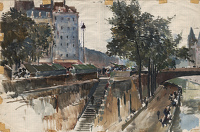
Charles Cundall
Seine Bookstalls & Fishermen
£3450
Between 1918 and 1970 Charles Cundall (1890-1971) exhibited nearly two hundred and fifty pictures at the Royal Academy and a further one hundred and seventy-five at the New English Art Club. One hundred and forty-nine of his oil paintings – and countless works on paper – found their way into British public collections. Statistics alone do not argue that an artist is important but it is surprising that this is the first publication on Cundall’s life and work…. In two genres Cundall excelled – he was a master of painting crowd scenes – whether at Irish cattle markets or sporting events such as Derby Day. He was also a master of painting industrial scenes, with compositions spanning half a century recording sites in England, Scotland, Wales and Greece. That a monograph did not appear in Cundall’s lifetime is an accident of history rather than a consequence of critical selection – in the mid 1960s the industrialist and collector Harald Peake commissioned William Gaunt (the art historian and author best known for The Pre-Raphaelite Tragedy, 1942) to produce a book, The Life and Work of Charles Cundall. Cundall assisted in the project and Gaunt acknowledged that the text produced was ‘indebted to the artist himself for much of the information.’ The project appears to have been abandoned after Cundall’s death in 1971. The original typescript, rediscovered amongst Cundall’s papers, and published by Liss Llewellyn in 2016.
Cundall’s first RA exhibit in 1918 was rapidly followed by a succession of regular appearances at the Summer Exhibition. His first one-man show in 1923 at the Grosvenor Galleries was followed by five solo shows that spanned a fifty-year career. At the beginning of the Second World War he was appointed an official war artist, one of only thirty-seven to be salaried by the War Artists’ Advisory Committee. It was in this capacity that Cundall first met Air Commodore Harald Peake, who as director of RAF Public Relations, was responsible for choosing Cundall’s assignments. This association was fortuitous Peake, who was hostile to the modernist tendencies of some of the other war artists, enthusiastically promoted Cundall, in spite of resistance on the part of Kenneth Clark. After a century of innovation characterised by an ever-increasing appetite for modernism, the figurative pictures of Cundall might seem rather dull or at best, to a contemporary audience, little more than quaint. Stylistically they belong to the 19th century impressionist tradition of painting en plein air. As Gaunt pointed out, ‘Cundall never felt the compulsion to look inwards rather than outwards. ...Style for him was a quality that developed subconsciously.’ Should the fact that his paintings are easy to engage with be seen as a weakness? The visual argument presented in this publication would suggest otherwise. After the war, as Chairman of the Steel Company of Wales, Peake commissioned Cundall to paint a series of paintings of the burgeoning production plants centered on Port Talbot in Glamorganshire – used in a series of advertisements. In combining grand scale traditional landscapes with epic modern day industrial subjects these paintings are amongst Cundall’s most original works.
Like the masters whom he most admired, among them Constable, Gainsborough and Stubbs, Corot and the Impressionists, Cundall’s working technique was dependent upon sketching on the spot – ‘aids to memory’ as Gaunt called them – to create images with colour notes that might later be worked up into larger paintings in the studio. Using transparent medium such as tracing paper and celluloid, Cundall often developed compositions by overlaying consecutive images. In the process he was sometimes obliged to add two and then three sheets as the image spilled over.
Whilst Cundall's studio paintings were often impressively large in scale his working sketches – which at times display a vitality unrivalled by his contemporaries – remain amongst his most engaging works. Whether in the theatre of war, or more favoured haunts of the left bank of the Seine or a quayside of Manhattan, they all share the quality that the critic T.W. Earp praised in 1938 as ‘the quick movement, the dance of colour, and the feeling that these are happening in open air, which makes it so brilliant an impression’.
In a century that saw the flowering of photography and film, which to some degree challenged the pre-eminence of painting, Cundall’s unerring commitment to traditional brushwork has left a remarkable legacy: a pageant recording the changing panorama of landscapes and events that marked the half century to which Cundall bore witness.
 sold
sold  reserved
reserved  private collection
private collection